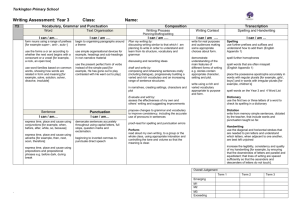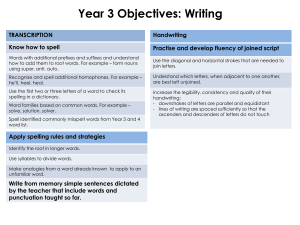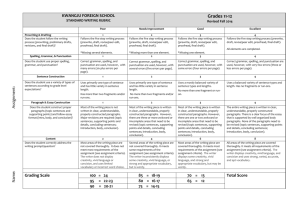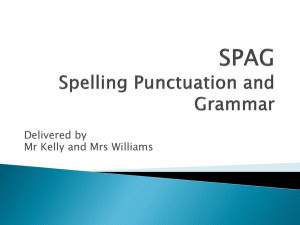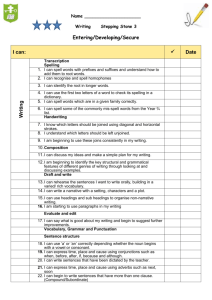Progression in Writing Stanley Grove Primary Academy 2015
advertisement
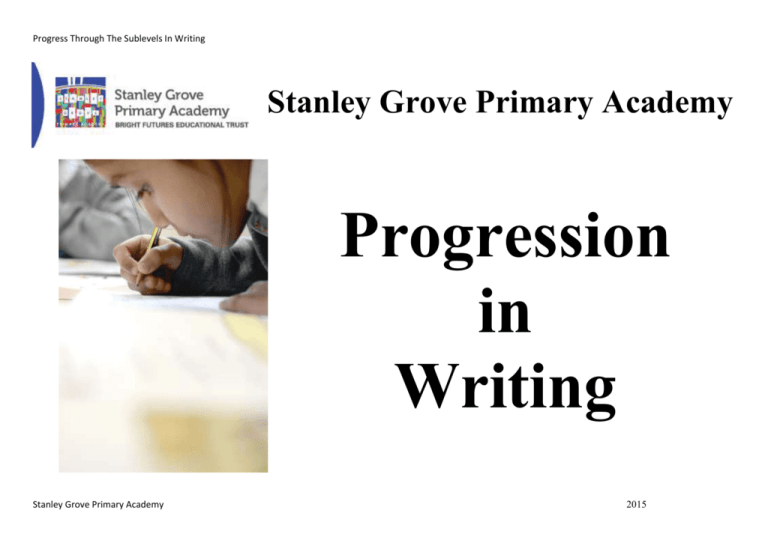
Progress Through The Sublevels In Writing Stanley Grove Primary Academy Progression in Writing Stanley Grove Primary Academy 2015 Progress Through The Sublevels In Writing Aspects of Writing to be Assessed Composition and Effect 2016 Assessment Performance Descriptors Text Structure Organisation End of Key Stage 1 Planning Below National Standard Drafting Towards National Standard Evaluating At National Standard Editing and Proof-reading. At Mastery Standard Sentence Structure Punctuation End of Key Stage 2 Applying Vocabulary At National Standard Grammar Expected Coverage for Year Groups Punctuation Year 3 Expectation Handwriting Year 4 Expectation Spelling Stanley Grove Primary Academy Year 5 Expectation 2015 Progress Through The Sublevels In Writing Composition and Effect. 7aps/1c 9aps/1b 11aps/1a 13aps//2c 15aps/2b 17aps/2a 19aps/3c 21aps/3b 23aps/3a Recognisable letters and simple words and phrases are used to convey meaning. Writing can generally be read without mediation. Pupil uses appropriate vocabulary, making choices between alternatives supplied, e.g. word banks. Adjectives for description Some interesting descriptive language used, e.g. for appearance, feelings, characters and settings. Considers and selects from alternative word choices related to the subject matter. Writes for different purposes, when prompted, but may not always maintain form when: Writing narratives about personal experiences and those of others (real and fictional) writing about real events writing poetry. Words chosen for effect. Variation in word choices, some of which is ambitious; (adjectives and nouns) Makes adventurous word and language choices appropriate to the style and purpose of the text. Dialogue or actions show character and viewpoint. Uses a range of verbs and adjectives for impact. Most features of appropriate text-type are executed with increasing confidence. Organise paragraphs around a theme In narratives, create settings, characters and plot Detail is used to engage the reader. Simple but appropriate text features apparent. Sustains form in narrative, including use of person and time. Produces a variety of written pieces for different purposes, maintaining form when: writing narratives about personal experiences and those of others (real and fictional) writing about real events o writing poetry Uses a range of technical and descriptive language. Adopts and maintains an appropriate form throughout longer pieces of writing for different purposes. Varies the use of verbs and adjectives to achieve impact. Adverbs are used to add detail to actions. Characters are created with some interaction to reveal feelings. In non-narrative material, using simple organisational devices such as headings and sub-headings Word use is lively and imaginative intended to amuse, entertain, etc. Writing may need to be mediated to be understood. Begins to write in different forms; e.g. lists, captions, simple stories. There may be some simple but appropriate vocabulary linked to the context. Attempts to write simple sentences and sentence-like structures to form short narratives based on fictional and real experiences. Narrative or nonnarrative identifiable Creates simple poems. Begins to use story language Stanley Grove Primary Academy Selects nouns to be specific, e.g. Ferrari instead of car. Begins to use technical language appropriate to texttype. Attempts to engage reader through detail or word choices. The beginnings of a conscious written style are evident, e.g. directly addressing the reader. Carefully selected detail is included to support purpose and engage reader’s interest. Some vocabulary is chosen to add interest or clarity or to introduce opinion or persuasion. In narrative, a range of devices are used to describe settings. 2015 Progress Through The Sublevels In Writing 25aps/4c 27aps/4b 29aps/4a 31aps/5c 33aps/5b 35aps/5a Above 36aps/6 Settings are described in some detail. Main ideas are sustained and developed in a logical way. Elements of description, action and characterisation are well developed and may be interwoven. There are direct attempts to involve the reader. The writer may comment upon the character’s thoughts and feelings. Appropriate style and form selected to suit specific purpose and audience, drawing on knowledge of different text types. Pace is varied. Textually appropriate writing style is shown through a range of sentences employed for specific effects. Imaginative treatment of appropriate materials, familiarity with conventions of a variety of forms, adapting them when needed to suit purpose and audience, not always successfully, e.g. deliberate use of inappropriate register for humour, clear emphasis on narration rather than plot Characters are developed through description and/or dialogue. Writing is lively to interest, inform or engage the reader. There is significant interaction between characters using action or dialogue. Well chosen and effective vocabulary is sometimes used Appropriate written style is consistent. Information is clearly presented, including detail to add interest, persuade, etc. Uses different narrative techniques to engage and entertain the reader. Viewpoint is consistent. Appropriate tone and style is mostly consistent. Character dialogue and action is used to carry narrative forward. Main features of texttype apparent. Some experimentation with different techniques such as breaking conventions to achieve specific effects, e.g. one word sentences; starting with ‘And’. Vocabulary is appropriate to task, audience and purpose, chosen to convey shades of meaning. Characters convey thoughts and emotions. Word choice supports purpose with increasing precision. Elements of description, action and characterisation are combined effectively. The passive voice may be used to create suspense or for e.g. science reports. Experiments with language, including the use of imagery, alliteration, rhythm and rhyme. May address the reader directly. The reader’s interest is maintained through use different narrative techniques. Vocabulary is varied and appropriate including use of specific and technical words to enhance precision and economy. Vocabulary is chosen to reflect shades of meaning, e.g. irritated, angry, furious, apoplectic. The style of the piece demonstrates the writer’s control over the language. Varied vocabulary is used confidently to create effects. Sustained awareness of the reader is shown. Narrative theme is developed. Informal or formal style is used and is consistent. Convincing, individual voice or point of view established and mostly sustained throughout, e.g. authoritative expert view, convincing characterisation, adopting a role Level of formality used for purpose and audience generally appropriate and a range of stylistic devices used to achieve effect, not always successfully, e.g. controlled informality, generalisations or shifts between conversational style and more literary language. Vocabulary chosen generally appropriate to purpose and audience. A range of vocabulary generally varied and often ambitious, even though choices not always apt. Confident use of grammar appropriate to text type. Organise paragraphs around a theme In narratives, create settings, characters and plot In non-narrative material, using simple organisational devices such as headings and sub-headings Plan their writing by: identifying the audience for & purpose of the writing, selecting the appropriate form & using other similar writing as models Plan writing by: identifying the audience & purpose of the writing, selecting the appropriate form & using other similar writing as models for their own Plan their writing by: noting and developing initial ideas drawing on reading and research where necessary Plan their writing by: noting and developing initial ideas, drawing on reading and research where necessary Plan their writing by: in narratives considering how authors have developed characters and settings in what they have read, listened to or seen performed Selecting appropriate grammar and vocabulary, understanding how such choices can change and enhance meaning. Perform their own compositions using appropriate intonation, volume and movement so that meaning is clear Stanley Grove Primary Academy 2015 Progress Through The Sublevels In Writing Text Structure, Organisation, Planning, Drafting, Evaluating, Editing and Proof-reading. 7aps/1c Writing is orientat ed correctl y, (top to bottom, left to right). Some ideas may be linked by ‘and’. 9aps/1b Simple beginning, middle and end are becoming apparent through imitated story language. Before writing, sentences are planned by saying out loud what the writing will be about using oral composition to recognise where the sentence begins and ends. 11aps/1a Ideas are sequenced appropriately, e.g. stories have a beginning, middle and an end or instructions are in the correct order. Some formulaic phrases are used to indicate the start / end, e.g. once upon a time, one day, the end. Some events or ideas are in an appropriate order Writing is discussed with the teacher and other pupils to check that what they have written makes sense and make simple changes where suggested. 13aps/2c Writing begins to show characteristics of chosen form based on the structure of known texts. 15aps/2b Organisation reflects the purpose of the writing, e.g. Instructions. Chronological and nonchronological texts show simple structures. Some use of basic layout conventions are used. Uses the drafting process to: say out loud and plan what the writing will be about write down some ideas or key words, including some new vocabulary drawn from listening to, and talking about, whole books write sentences which are sequenced to form short narrative Writing is discussed with the teacher and other pupils to: consider word choice, grammar and punctuation o make simple changes where appropriate. Related ideas are grouped together. Uses connectives that signal time, e.g. then, after, before, meanwhile. Re-reads own writing to check that what is written makes sense. 17aps/2a Uses appropriate language and structures for the textform. Uses the drafting process to: gather and write down ideas and key words, including new vocabulary drawn from reading, and discussion of different types of writing encapsulate what is to be said, sentence by sentence, to compose meaningful narratives. Pupil starts to show awareness of paragraphs. Writing is discussed with the teacher and other pupils to: evaluate the effective use of word choice, grammar and punctuation make appropriate additions, revisions and corrections. Appropriate presentational features selected to suit particular writing purpose on paper and on screen. Re-reads own writing to check for meaning and the correct, consistent use of tense, including verbs in the continuous/progressive form. 19aps/3c In narrative, the main features of story structure are used to organise events – openings and endings are indicated. Story structure is present but may not be balanced, e.g. long beginnings and sudden endings. In non-narrative, some simple layout features are used. There are some links between ideas but these may not be clear Uses the drafting process to gather and write down ideas and key words, including new vocabulary, drawn from a wide range of reading across the curriculum. Pupil starts to group related material into short paragraphs but links between paragraphs may be unclear. In response to discussion or comment: evaluates their writing according to purpose, the effectiveness of word choice, grammar and punctuation makes simple additions, corrections and revisions to their writing, often without prompting. 21aps/3b In narrative, pupil uses beginning, middle and end in which events are Sequenced logically and the main conflict is resolved. Plan writing by discussing writing similar to that which they are planning to write to learn from its structure, vocab and grammar The story is balanced and there is an attempt to create pace Proof-read for spelling and punctuation errors In non narrative, the layout attempts to organise key elements. Related material is grouped into paragraphs. Some attempts to link paragraphs. 23aps/3a Text is organised into paragraphs to distinguish between different information, events or processes. Draft & write by composing & rehearsing sentences orally, progressively building a varied & rich vocabulary & an increasing range of sentence structures Narrative events are well paced. Cohesion is achieved through use of nouns and their related pronouns. Evaluate and edit by assessing the effectiveness of their own and others’ writing and suggesting improvements Writes narratives with a build up and complication that lead towards a defined ending. Evaluate and edit by assessing the effectiveness of their own and others’ writing and suggesting improvements Each element of narrative is grouped into separate paragraphs. Evaluate and edit by proposing changes to grammar and vocabulary to improve consistency, including the accurate use of pronouns in sentences Discussing and recording ideas Read aloud own writing to a group or whole class, using appropriate intonation and controlling tone and volume so that the meaning is clear. Some of the grammatical terminology in the ‘English programmes of study: key stages 1 and 2 National curriculum in England - Appendix 2’ is used when discussing writing. Stanley Grove Primary Academy 2015 Progress Through The Sublevels In Writing 25aps/4c 27aps/4b 29aps/4a 31aps/5c 33aps/5b 35aps/5a Above 36aps/6 In narrative, attempts are made to vary the pace Ideas are sustained and some are developed within and between paragraphs or sections Begins to experiment with the order of sections and paragraphs to achieve different effects. Development of ideas is managed across the text e.g. closing refers back to opening. Use of a range of connecting words and phrases appropriate to text-type. Layout is fully developed, appropriate and often designed by the pupil. It supports the coherent organisation of ideas into paragraphs. Material is clearly controlled and sequenced, taking account of the reader’s likely reaction, e.g. paragraphs of differing lengths, use of flashback in narrative, anticipating reader’s questions Layout is appropriate and supports the purpose Within paragraphs/sections a range of devices support cohesion e.g. secure use of pronouns, connectives Some appropriate layout features are used to enhance organisation. Causal and logical connectives are used in addition to those that signal time, e.g. however, therefore. In nonnarrative material, using simple organisational devices [for example, headings and subheadings] Uses paragraphs of varying length to achieve pace and emphasis, and to structure the plot. Paragraphs used to signal a change of time, scene, action, mood or person. Use of varied structures to shape and organise text coherently. Ideas are sustained and developed within and between paragraphs or sections. Non-fiction contains relevant introduction and clear presentation of information. Structure is well developed with clear evidence of the chosen form. Events related logically so that writing is coherent and coverage is good. A widening range of organisational or presentational elements may be included. Pupil begins to create own layouts to present information on paper or on screen. There is a balance of dialogue, action and description in narrative. Plan writing by discussing writing similar to that which they are planning to write to learn from its structure, vocab and grammar Draft & write by composing & rehearsing sentences orally, progressively building a varied & rich vocabulary & an increasing range of sentence structures Evaluate and edit by assessing the effectiveness of their own and others’ writing and suggesting improvements Evaluate and edit by proposing changes to grammar and vocabulary to improve consistency, including the accurate use of pronouns in sentences In non-chronological writing, introduces, develops and concludes paragraphs appropriately. Pupil presents texts which integrate words images and sounds clearly and effectively. A range of devices is used within and between paragraphs to achieve cohesion. Chronology or logical sequence is maintained throughout. ICT presentations are clear, effective and have impact. A range of features clearly signal overall direction of the text for the reader, e.g. opening paragraphs that introduce themes clearly, paragraph markers, links between paragraphs. Construction of paragraphs clearly supports meaning and purpose, e.g. paragraph topic signalled and then developed, withholding of information for effect, thematic links between paragraphs. Within paragraphs, cohesive devices contribute to emphasis and effect. Draft and write by: in narratives, describing settings, characters and atmosphere and integrating dialogue to convey character and advance the action Draft and write by: selecting appropriate grammar and vocabulary Draft and write by: using a range of devices to build cohesion within paragraphs Draft and write by: using further organisational and presentational devices to structure text and to guide the reader Evaluate and edit by: assessing the effectiveness of their own writing Proof-read for spelling and punctuation errors Evaluate and edit by: proposing changes to vocabulary, grammar and punctuation to enhance effects Read aloud own writing to a group or whole class, using appropriate intonation and controlling tone and volume so that the meaning is clear. Evaluate and edit by: ensuring the consistent and correct use of tense throughout a piece of writing Evaluate & edit by: ensuring correct subject-verb agreement when using singular & plural, distinguish between the language of speech & writing Draft and write by: précising longer passages Draft and write by: using a wide range of devices to build cohesion within and across paragraphs Evaluate and edit by: assessing the effectiveness of their own and others’ writing Evaluate and edit by: proposing changes to vocabulary, grammar and punctuation to enhance effects and clarify meaning Evaluate & edit by: ensuring correct subject-verb agreement when using singular & plural, distinguish between the language of speech & writing Proof-read for spelling and punctuation errors Stanley Grove Primary Academy 2015 Progress Through The Sublevels In Writing Sentence Structure, Punctuation, Applying Vocabulary, Grammar and Punctuation 7aps/1c 9aps/1b 11aps/1a 13aps/2c 15aps/2b 17aps/2a 19aps/3c 21aps/3b 23aps/3a Writes simple words and phrases Begins to join ideas with ‘and’. Writing demonstr ates some appropria te use of spaces between words Some use of capital letters. Writes simple sentences that makes sense. Uses simple sentences and compound sentences joined by ‘and’ ‘and’ to join words and clauses Uses full stops and capital letters more consistently. There is some use of capital letters and/or full stops to demarcate sentence boundaries and some use of question marks and exclamation marks. Some evidence of the use of other punctuation such as exclamation and question marks. Capital letters for some names of people, places and days of the week. Uses a range of connectives to make a compound sentence e.g. and, but because, so. Some coordination using and/but to join clauses Full stops, capital letters and question marks are used more consistently. Sentences start in a variety of ways. Writing is generally composed in effective simple and compound sentences which are grammatically correct. Writing is composed in effective simple and compound sentences, grammatically correct. All aspects of writing composition: applying vocabulary, grammar and punctuation at the national standard are embedded. Begins to use subordination such as ‘when’, ‘while’, ‘until’, ‘because’. Writing demonstrates confident and consistent use of: a variety of sentences with different structures and functions, correctly punctuated the present and past tense, including the progressive form, correctly chosen and consistently used throughout writing features of written Standard English. Use conjunctions, adverbs and prepositions to express time and cause Uses complex sentences with adverb starters, e.g. slowly, carefully; or a relative clause, e.g. The boy, who was caught stealing apples, was chased by the farmer’s dog. Punctuation is used correctly, including apostrophes for contractions and singular possession in nouns. Begins to use commas to mark embedded clauses. e.g. The pirate, with his cutlass clenched in his teeth, swung on to the ship. Y3 Grammar: formation of nouns using a range of prefixes, use of a/an, word families Uses apostrophe for possession. Use inverted commas to punctuate direct speech Uses a variety of sentences for effect e.g. long and short sentences for description or suspense. Extend the range of sentences with more than one clause by using a wider range of conjunctions e.g. when, if , because, although Starts sentences in a variety of ways. Begin to identify main and subordinate clauses Indicate possession by using the possessive apostrophe with singular nouns and regular plurals Subordination connectives are used between, at the beginning, and within sentences. We wore our wellies when we played in the puddles. When we played in the puddles we wore our wellies. Use the perfect form of verbs in contrast to the past tense Tense mostly accurate. Compose sa sentence orally and attempt to replicate it in writing. Shows some awarenes s of how full stops are used in writing or reading. Full stops may be used to mark the end of a line rather than a sentence. Writing begins to show an awareness of how full stops are used. Begins to join simple sentences with ‘and’. Some sentences demarcate d with capital letters and full stops. Sometime s attempts to match sentence structure to purpose. Pronouns are used to avoid repetition. Writing demonstrates appropriate use of: capital letters for some proper nouns and for the personal pronoun ‘I’ Begins to experiment with exclamation marks. Starts some sentences in different ways e.g. Subject; preposition; pronoun. Begins to use subordination to show time and reason Stanley Grove Primary Academy Past and present tense is mainly accurate Connectives used at the beginning and within sentences e.g. when, if. Full stops, capital letters and question marks used accurately. Uses capital letters, full stops, question marks or exclamation marks to demarcate most sentences with different functions. Exclamation marks used more effectively. Commas used to separate items in a list. There is some use of commas to separate items in a list and some attempted use of apostrophes for contraction and singular possession. Begins to experiment with speech marks. Mostly grammatically accurate sentences, sequenced to form short narratives. Uses first and third person consistently. Uses a range of connectives to signal time, e.g. first, next, then, after a while, eventually; Uses a range of connectives to signal cause/reason, e.g. because, so. Adds detail through noun phrases, e.g. golden coins; and adverbs, e.g. glistening brightly. Some expanded noun phrases for description words combined to make single clause sentences Speech marks attempted where appropriate. Appropriate use of capital letters for almost all proper nouns, adjectives, adverbs and expanded noun phrases to describe and specify the present and past tense, including the progressive form to mark actions in progress throughout writing co-ordination, using or/and/but o subordination, using when/if/that/ because grammatically accurate sentences with different forms and functions (statements, questions, exclamations and commands) features of written Standard English. Uses punctuation, almost always correctly (including: capital letters, full stops, exclamation marks and question marks to demarcate sentence boundaries; commas to separate items in lists; and apostrophes for some contracted forms and some singular possession in nouns). 2015 Accurate use of commas in a list and to mark clauses. Mostly accurate use of punctuation within dialogue and within the complete sentence. Progress Through The Sublevels In Writing 25aps/4c 27aps/4b 29aps/4a 31aps/5c 33aps/5b 35aps/5a Above 36aps/6 Complex sentences used appropriate to text Varied sentence starter techniques used, e.g. ing, ed, simile, adverbial. Conscious attempts to vary sentence structure and length to create intended effects. Uses sentence variation to contribute to the effectiveness of the writing. Uses subordinate clauses to add relevant detail to complex sentences. Writes sentences in an appropriate and effective style in relation to text type, audience and purpose, e.g. pace, buildup, suspense, draw the reader in with a question. Sentence structures are chosen to have a specific effect upon the reader. Controlled use of a variety of simple and complex sentences to achieve purpose and contribute to overall effect. Beginning to try different sentence lengths and structures to create effect. Extended use and control of complex sentences by deploying subordinate clauses effectively. Connectives are appropriate to text-type; e.g. discursive; explanatory; and indicate the relationship between clauses. Conventions are broken in order to achieve specific effects, e.g. starting a series of sentences with and to convey tedium or relentlessness Tense and person accurate. Appropriate word order selected for interest, precision, clarity or economy. Dialogue layout and punctuation accurate. Extended noun phrases are used to add detail, e.g. olden coins glistening brightly; flickering candle-light. Tense and person are accurate and consistent with noun verb agreement. Beginning to show an awareness of the difference between spoken and written language reflected in use of dialogue. Uses punctuation to clarify meaning in complex sentences. Begins to use the full range of punctuation, e.g. ellipsis, hyphen, brackets, colon, semicolon. Different speech punctuation used, such as split dialogue; speaker identified before, between and after dialogue. Mostly accurate use of commas to demarcate clauses. Extend the range of sentences with more than one clause by using a wider range of conjunctions, adverbs or prepositions Adverbials of place, e.g. walked wearily into the deep, dark forest; time, e.g.in the blink of an eye; or manner, e.g. stomping angrily out of the room; are used to add detail. Some sentences start with conjunctions; ‘although’, ‘despite’, ‘as’, ‘since’, ‘whenever’. Pupil adapts conventions to achieve creative effect. Uses the full range of punctuation appropriately. Punctuation is used to convey and clarify meaning and to integrate speech into longer sentences. Use ellipses Punctuation used for effect as well as demarcation. ‘No! Stop. . .‘ Tense manipulated for effect, e.g. diaries written in all three tenses, e. Confident use of a range of sentence features to clarify or emphasise meaning, e.g. fronted adverbials (‘Reluctantly, he…, Five days later, it…’), complex noun or prepositional phrases. Syntax and full range of punctuation are consistently accurate in a variety of sentence structures, with occasional errors in ambitious structures, e.g. only occasional comma splices, some use of semi-colons, not always accurate. Recognise vocabulary and structures that are appropriate for formal speech and writing, including subjunctive forms Use passive verbs to affect the presentation of information in a sentence Use the perfect form of verbs to mark relationships of time and cause Use modal verbs or adverbs to indicate degrees of possibility Use hyphens to avoid ambiguity Use semi-colons, colons or dashes to mark boundaries between independent clauses and a colon to introduce a list. Y4 Grammar: plural and possessive –s, verb inflections Use relative clauses beginning with who, which, where, when, whose, that or with an implied (i.e. omitted) relative pronoun Punctuating bullet points consistently Use fronted adverbials followed by commas Use commas to clarify meaning or avoid ambiguity in writing Indicate possession by using the possessive apostrophe with plural nouns Use brackets, dashes or commas to indicate parenthesis Learn the grammar and grammatical terminology for Stage 6: formal and informal speech and writing, synonyms and antonyms Use and punctuate direct speech using inverted commas and other punctuation: a comma after the reporting clause, end punctuation within inverted commas Learn the grammar for Y5. Choose nouns or pronouns appropriately for clarity & cohesion & to avoid repetition e.g. Harry (the noun) is appropriately replaced by the pronoun ‘he’, ‘him’, ‘his’ etc) Use expanded noun phrases to convey complicated information concisely Use conjunctions, adverbs and prepositions to express time and cause Use & understand the Y5 grammatical terminology Use and understand the grammatical terminology for Y4 Stanley Grove Primary Academy 2015 Progress Through The Sublevels In Writing Spelling 7-12aps/1 13-18aps/2 19-2/4aps/3 25-30aps/4 31-36aps/5 Above 36aps/6 Usually correct spelling of simple highfrequency words Usually correct spelling of: • High frequency grammatical function words In most writing correct spelling of: • Some common grammatical function words Across a range of writing correct spelling of: • Most common grammatical function words, including adverbs with –ly formation Correct spelling of: • Grammatical function words Generally correct spelling throughout, including some ambitious, uncommon words Phonetically plausible attempts at words with digraphs and double letters Sufficient number of recognisable words for writing to be readable, including, e.g. use of letter names to approximate syllables and words Words containing each of the 40+ phonemes already taught. Using the spelling rule for adding –s or –es as the plural marker for nouns and the third person singular marker for verbs. Common exception words. The days of the week. Using the prefix un–. Name the letters of the alphabet. Naming the letters of the alphabet in order. Using –ing, –ed, –er and –est where no change is needed in the spelling of root words [for example, helping, helped, helper, eating, quicker. Using letter names to distinguish between alternative spellings of the quickest] same sound add prefixes and suffixes. Apply simple spelling rules and guidance, as listed in English Appendix 1. Write from memory simple sentences dictated by the teacher that include words using the GPCs and common exception words taught so far. Usually correct spelling of: • Common single-morpheme content/lexical words Segmenting spoken words into phonemes and representing these by graphemes, spelling many correctly Distinguishing between homophones and near homophones Add suffixes to spell longer words, including –ment, –ness, –ful, –less, –ly Learning new ways of spelling phonemes for which one or more spellings are already known, and learn some words with each spelling, including a few common homophones Apply spelling rules and guidance, as listed in English Appendix 1 write from memory simple sentences dictated by the teacher that include words using the GPCs, common exception words and punctuation taught so far. Learning to spell common exception words Learning to spell more words with contracted forms Learning the possessive apostrophe (singular) [for example, the girl’s book] In most writing correct spelling of: • Common content/lexical words with more than one morpheme, including compound words Use further prefixes and suffixes and understand how to add them (English Appendix 1) Across a range of writing correct spelling of: • Regularly formed content/lexical words, including those with multiple Morphemes Across a range of writing correct spelling of: • Most past and present tense inflections, plurals Spell further homophones Spell words that are often misspelt (English Appendix 1) Use further prefixes and suffixes and understand how to add them (English Appendix 1) Spell further homophones Place the possessive apostrophe accurately in words with regular plurals [for example, girls’, boys’] and in words with irregular plurals [for example, children’s] Use the first two or three letters of a word to check its spelling in a dictionary Write from memory simple sentences, dictated by the teacher, that include words and punctuation taught so far. Proofread for spelling and punctuation errors Spell words that are often misspelt (English Appendix 1) Place the possessive apostrophe accurately in words with regular plurals [for example, girls’, boys’] and in words with irregular plurals [for example, children’s] Use the first two or three letters of a word to check its spelling in a dictionary Write from memory simple sentences, dictated by the teacher, that include words and punctuation taught so far. Proofread for spelling and punctuation errors Correct spelling of: • Almost all inflected words Correct spelling of: • Most derivational suffixes and prefixes Correct spelling of: • Most content/lexical words Use further prefixes and suffixes and understand the guidance for adding them Spell some words with ‘silent’ letters [for example, knight, psalm, solemn] Continue to distinguish between homophones and other words which are often confused Use knowledge of morphology and etymology in spelling and understand that the spelling of some words needs to be learnt specifically, as listed in English Appendix 1 Use dictionaries to check the spelling and meaning of words Use the first three or four letters of a word to check spelling, meaning or both of these in a dictionary. Use a thesaurus. Stanley Grove Primary Academy words with complex sound/symbol relationships words with unstressed syllables multiletter vowel and consonant symbols likely errors occasionally in complex words such as outrageous, exaggerated, announcing, parallel. Use further prefixes and suffixes and understand the guidance for adding them Spell some words with ‘silent’ letters [for example, knight, psalm, solemn] Continue to distinguish between homophones and other words which are often confused Use knowledge of morphology and etymology in spelling and understand that the spelling of some words needs to be learnt specifically, as listed in English Appendix 1 Use dictionaries to check the spelling and meaning of words Use the first three or four letters of a word to check spelling, meaning or both of these in a dictionary. Use a thesaurus. 2015 Progress Through The Sublevels In Writing Handwriting 7-12aps/1 13-18aps/2 19-24aps/3 25-30aps/4 31-36aps/5 Above 36aps/6 Most letters correctly formed and orientated Letters generally correctly shaped but inconsistencies in orientation, size and use of upper/lower-case letters. In most writing: • Legible style, shows accurate and consistent letter formation, sometimes joined. In most writing: • Legible style, shows accurate and consistent letter formation, mostly joined. In most writing: • Legible style, shows accurate and consistent letter formation, joined. Use the diagonal and horizontal strokes that are needed to join letters and understand which letters, when adjacent to one another, are best left unjoined. In most writing: • Handwriting style adapted for different purposes – printing, capitalization, bold etc. Write legibly, fluently and with increasing speed by: • Choosing which shape of a letter to use when given choices and deciding whether or not to join specific letters • Choosing the writing implement that is best suited for a task. Spaces between words Upper and lower case sometimes distinguished Sit correctly at a table, holding a pencil comfortably and correctly. Begin to form lowercase letters in the correct direction, starting and finishing in the right place. Form capital letters. Form digits 0-9. Understand which letters belong to which handwriting ‘families’ (i.e. letters that are formed in similar ways) and to practise these. Clear letter formation, with ascenders and descenders distinguished, generally upperand lower-case letters not mixed within words. Form lowercase letters of the correct size relative to one another. Start using some of the diagonal and horizontal strokes needed to join letters and understand which letters, when adjacent to one another, are best left unjoined. Write capital letters and digits of the correct size, orientation and relationship to one another and to lower case letters. Use spacing between words that reflects the size of the letters. Stanley Grove Primary Academy Increase the legibility, consistency and quality of their handwriting [for example, by ensuring that the downstrokes of letters are parallel and equidistant; that lines of writing are spaced sufficiently so that the ascenders and descenders of letters do not touch Use the diagonal and horizontal strokes that are needed to join letters and understand which letters, when adjacent to one another, are best left unjoined. Increase the legibility, consistency and quality of their handwriting [for example, by ensuring that the downstrokes of letters are parallel and equidistant; that lines of writing are spaced sufficiently so that the ascenders and descenders of letters do not touch In most writing: • Handwriting style adapted for different purposes – printing, capitalization, bold etc. Write legibly, fluently and with increasing speed by: • Choosing which shape of a letter to use when given choices and deciding whether or not to join specific letters • Choosing the writing implement that is best suited for a task 2015
